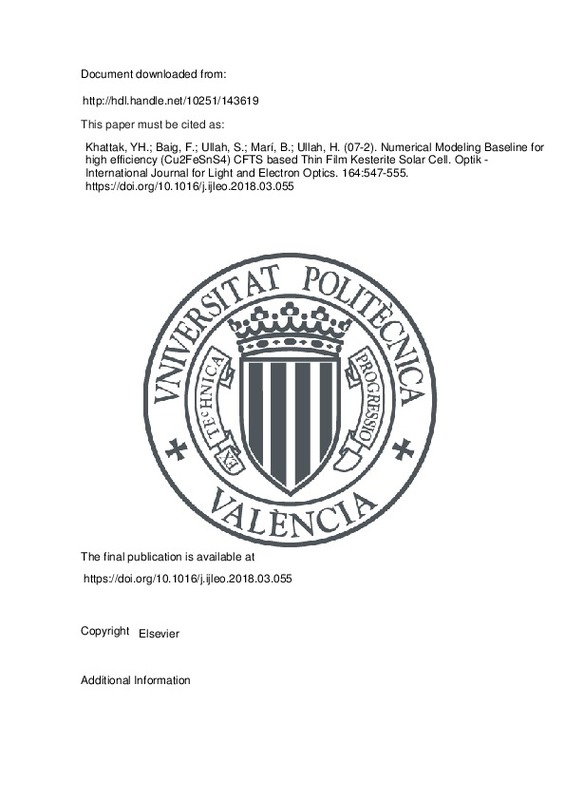JavaScript is disabled for your browser. Some features of this site may not work without it.
Buscar en RiuNet
Listar
Mi cuenta
Estadísticas
Ayuda RiuNet
Admin. UPV
Numerical Modeling Baseline for high efficiency (Cu2FeSnS4) CFTS based Thin Film Kesterite Solar Cell
Mostrar el registro sencillo del ítem
Ficheros en el ítem
| dc.contributor.author | Khattak, Yousaf Hameed
|
es_ES |
| dc.contributor.author | Baig, Faisal
|
es_ES |
| dc.contributor.author | Ullah, Shafi
|
es_ES |
| dc.contributor.author | Marí, B.
|
es_ES |
| dc.contributor.author | Ullah, Hanif
|
es_ES |
| dc.date.accessioned | 2020-05-19T03:02:31Z | |
| dc.date.available | 2020-05-19T03:02:31Z | |
| dc.date.issued | 2018-07 | es_ES |
| dc.identifier.issn | 0030-4026 | es_ES |
| dc.identifier.uri | http://hdl.handle.net/10251/143619 | |
| dc.description.abstract | [EN] Cu2FeSnS4 (CFTS) is auspicious nontoxic and earth abundant semiconductor compound having kesterite symmetrical structure. It is an attractive and suitable material for the fabrication of low cost, high efficiency and sustainable thin film photovoltaic cell. ¿¿¿¿¿¿¿¿ based kesterite photovoltaic cell device modeling was performed in this work. The influence of device parameters such as the thickness, acceptor and donor carrier concentration densities of absorber and electron transport layer (ETL), effect of back contact metal work function and the temperature effect on the performance of ¿¿¿¿¿¿¿¿ based kesterite photovoltaic cell is analyzed by using one dimensional solar cell capacitance simulator (SCAPS) software. In this work, promising optimized results had been achieved with the conversion efficiency of 19.97%, fill factor (¿¿¿¿) 85.94 %, short-circuit current (¿¿¿¿¿¿ ) 23.37 ¿¿¿¿/¿¿¿ 2 and open circuit voltage (¿¿¿¿¿¿ ) 0.995V. The above results will give imperative baselines and feasible directions for the fabrication of higher efficiency ¿¿¿¿¿¿¿¿ based photovoltaic cell | es_ES |
| dc.description.sponsorship | This work was supported by Ministerio de Economia y Competitividad (ENE2016-77798-C4-2-R) and Generalitat valenciana (Prometeus 2014/044). | es_ES |
| dc.language | Inglés | es_ES |
| dc.publisher | Elsevier | es_ES |
| dc.relation.ispartof | Optik - International Journal for Light and Electron Optics | es_ES |
| dc.rights | Reconocimiento - No comercial - Sin obra derivada (by-nc-nd) | es_ES |
| dc.subject | SCAPS | es_ES |
| dc.subject | Photovoltaics | es_ES |
| dc.subject | Cu2FeSnS4 | es_ES |
| dc.subject | CFTS | es_ES |
| dc.subject | Kesterite | es_ES |
| dc.subject | Solar cell | es_ES |
| dc.subject | Numerical Analysis | es_ES |
| dc.subject.classification | FISICA APLICADA | es_ES |
| dc.title | Numerical Modeling Baseline for high efficiency (Cu2FeSnS4) CFTS based Thin Film Kesterite Solar Cell | es_ES |
| dc.type | Artículo | es_ES |
| dc.identifier.doi | 10.1016/j.ijleo.2018.03.055 | es_ES |
| dc.relation.projectID | info:eu-repo/grantAgreement/GVA//PROMETEOII%2F2014%2F044/ES/Técnicas de Fabricación Avanzada y Control de Calidad de nuevos materiales multifuncionales en movilidad sostenible/ | es_ES |
| dc.relation.projectID | info:eu-repo/grantAgreement/MINECO//ENE2016-77798-C4-2-R/ES/APROVECHAMIENTO DE LA LUZ SOLAR CON PROCESOS DE DOS FOTONES-TF/ | es_ES |
| dc.rights.accessRights | Abierto | es_ES |
| dc.contributor.affiliation | Universitat Politècnica de València. Departamento de Física Aplicada - Departament de Física Aplicada | es_ES |
| dc.description.bibliographicCitation | Khattak, YH.; Baig, F.; Ullah, S.; Marí, B.; Ullah, H. (2018). Numerical Modeling Baseline for high efficiency (Cu2FeSnS4) CFTS based Thin Film Kesterite Solar Cell. Optik - International Journal for Light and Electron Optics. 164:547-555. https://doi.org/10.1016/j.ijleo.2018.03.055 | es_ES |
| dc.description.accrualMethod | S | es_ES |
| dc.relation.publisherversion | https://doi.org/10.1016/j.ijleo.2018.03.055 | es_ES |
| dc.description.upvformatpinicio | 547 | es_ES |
| dc.description.upvformatpfin | 555 | es_ES |
| dc.type.version | info:eu-repo/semantics/publishedVersion | es_ES |
| dc.description.volume | 164 | es_ES |
| dc.relation.pasarela | S\355771 | es_ES |
| dc.contributor.funder | Generalitat Valenciana | es_ES |
| dc.contributor.funder | Ministerio de Economía y Competitividad | es_ES |







![[Cerrado]](/themes/UPV/images/candado.png)

